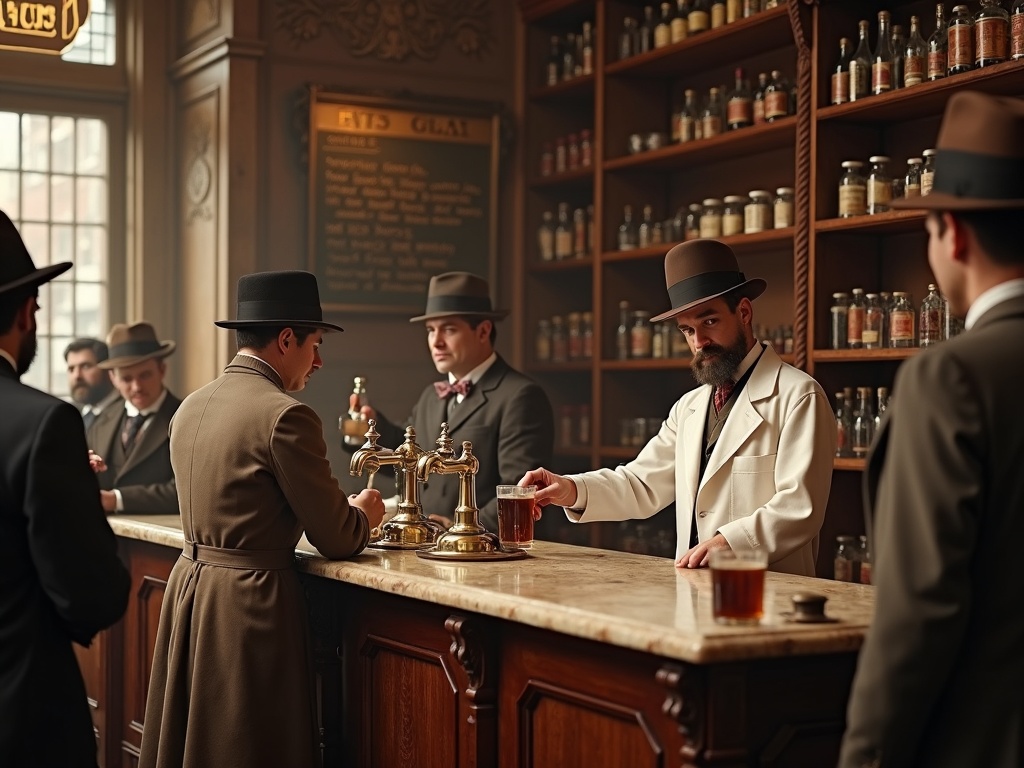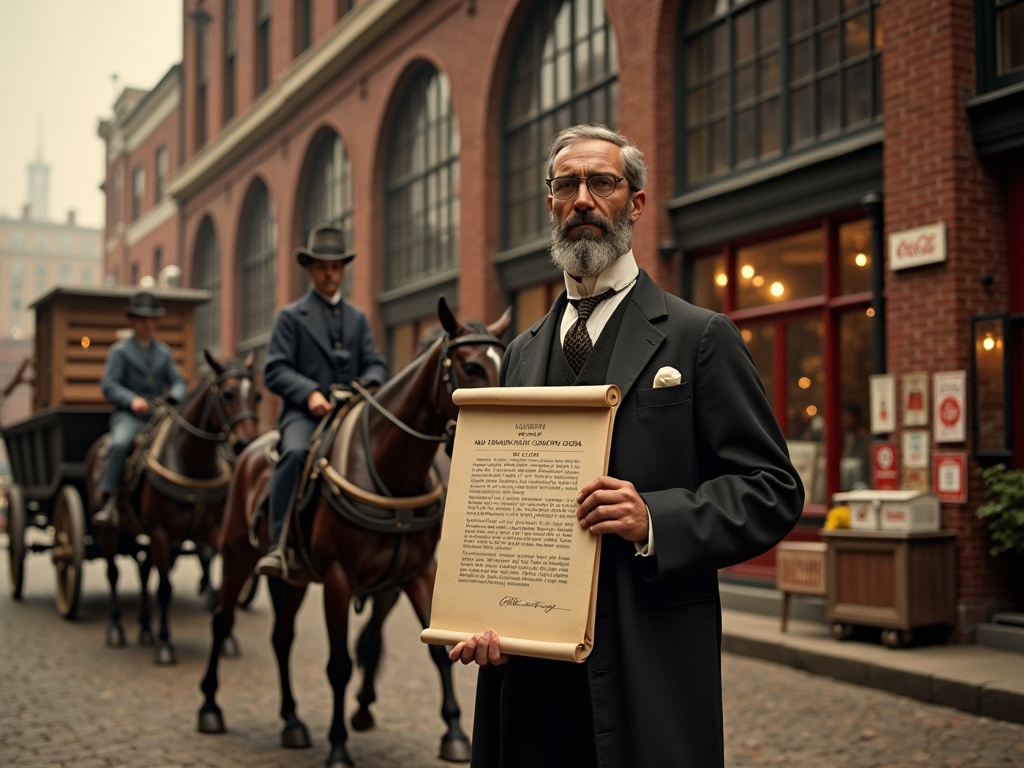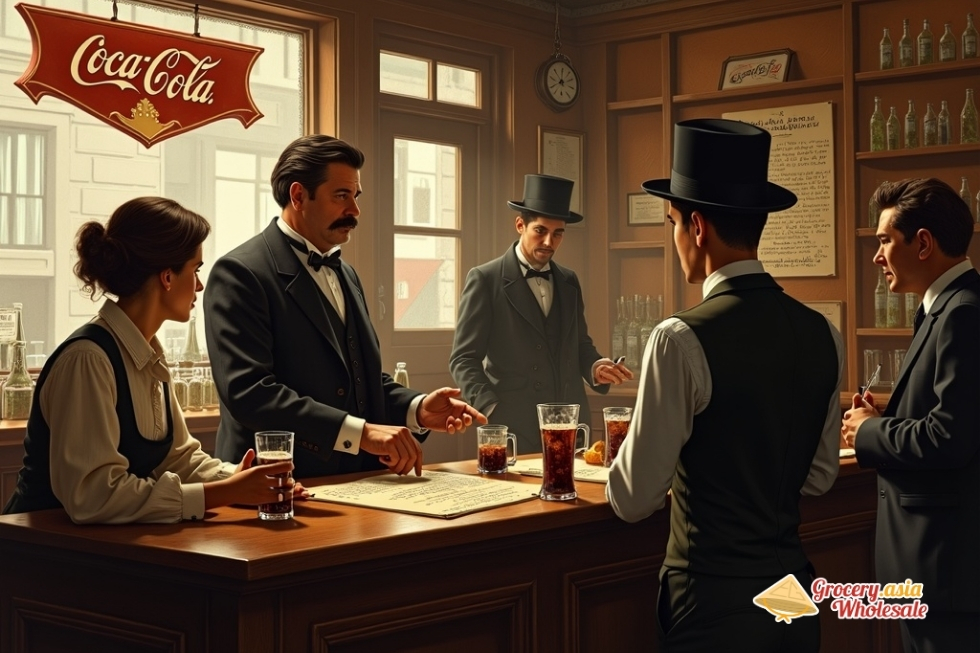No products in the cart.
Beverages News, Coca-Cola Carbonated Soft Drinks, Soft Drinks
When Was Coke Founded and Who Created It?
Coca-Cola emerged on May 8, 1886, when pharmacist Dr. John Stith Pemberton sold the first glass of his medicinal tonic at Jacobs’ Pharmacy in Atlanta, Georgia for five cents. The beverage evolved from averaging just nine servings per day in its first year to becoming a global phenomenon serving 1.9 billion drinks daily worldwide after businessman Asa Griggs Candler purchased the rights for $2,300 in 1888 and established The Coca-Cola Company in 1892.
Table of Contents
Key Takeaways
- Dr. John Stith Pemberton created Coca-Cola on May 8, 1886, as a medicinal tonic to help with his morphine addiction from Civil War injuries, initially marketing it as a cure for headaches and fatigue.
- Asa Griggs Candler purchased complete rights to the formula for $2,300 in 1888 and officially founded The Coca-Cola Company in 1892, converting it from a local pharmacy drink into a national brand.
- Frank Robinson, Pemberton’s bookkeeper, created both the “Coca-Cola” name and the distinctive flowing script logo that remains virtually unchanged today.
- The original formula contained approximately nine milligrams of cocaine per glass from coca leaves, which was completely removed by 1903 while maintaining the flavor through de-cocainized coca leaf extract.
- From selling nine servings per day in 1886, Coca-Cola now serves 1.9 billion drinks daily across over 200 countries, making it one of the most valuable brands globally.
For further historical details and brand evolution, you can visit the official website of The Coca-Cola Company.
When Was Coke Founded? and Who Created It?
The Historic Launch at Jacobs’ Pharmacy
I can trace Coca-Cola’s origins back to a specific date and location that changed beverage history forever. On May 8, 1886, the very first glass of Coca-Cola was sold at Jacobs’ Pharmacy in Atlanta, Georgia. Dr. John Stith Pemberton, a local pharmacist, created this unique formula that would eventually become one of the most recognizable brands on Earth.
The original Coca-Cola wasn’t sold in bottles or cans as we know today. Instead, it was served as a soda fountain drink, mixed fresh with carbonated water right at the pharmacy counter. Customers paid five cents per glass for this new beverage, which Pemberton initially marketed as a patent medicine claiming to cure headaches and relieve fatigue.
Humble Beginnings and Early Struggles
The early days of Coca-Cola reveal just how far this brand has come from its modest start. During its first year of operation, the drink averaged only nine servings per day. These numbers seem almost impossible to believe when you consider that Coca-Cola’s global presence now reaches every corner of the world.
Pemberton’s creation didn’t immediately capture the public’s attention. The slow start makes the eventual success story even more remarkable. Frank Robinson, Pemberton’s bookkeeper and business partner, played a crucial role in the brand’s development. He not only suggested the name “Coca-Cola” but also designed the distinctive script logo that remains largely unchanged today.
The transformation from a local pharmacy drink to a global phenomenon began when Coke was invented and changed the beverage industry forever. Asa Griggs Candler purchased the rights to Coca-Cola from Pemberton in 1888 and aggressively marketed the product across the United States.
Candler’s business acumen turned Coca-Cola into a household name. He invested heavily in advertising and promotional materials, distributing free samples and branded merchandise. By 1895, Coca-Cola was being sold in every state and territory in the United States.
The contrast between those early nine servings per day and today’s consumption figures is staggering. Over 1.9 billion Coca-Cola servings are now consumed daily worldwide. This means that in just one day, more Coca-Cola is consumed than was sold in the first several decades of the company’s existence.
The May 8, 1886 date represents more than just the first sale of a beverage. It marks the beginning of what would become a cultural phenomenon that transcends borders, languages, and generations. From that single glass sold at Jacobs’ Pharmacy, Coca-Cola became a global icon that continues to shape how we think about branding, marketing, and consumer products.
The story of Coca-Cola’s founding demonstrates how a simple idea, combined with determination and smart business decisions, can evolve into something far beyond its creator’s original vision. Pemberton probably never imagined that his medicinal syrup would one day be enjoyed by billions of people across the globe, served in nearly 200 countries and territories.

Meet the Inventor: John Stith Pemberton’s Quest for a Medicinal Beverage
John Stith Pemberton brought a unique combination of medical knowledge and personal struggle to his creation of what would become the world’s most famous soft drink. As a pharmacist in Atlanta, he possessed the technical skills needed to develop complex formulations, but his journey to create Coca-Cola’s invention stemmed from deeply personal circumstances.
Pemberton’s service as a Confederate Civil War veteran left him with more than just memories of battle. After sustaining wounds during combat, he developed a morphine addiction—a widespread issue among veterans of that era who had limited alternatives for pain management. This addiction drove him to search for alternative remedies that could help him break free from his dependence while still addressing his medical needs.
From French Wine to Atlanta’s Temperance Movement
Pemberton’s initial solution came in the form of ‘Pemberton’s French Wine Coca’, a beverage he modeled after Vin Mariani, a popular French drink that combined wine with coca leaves. This formulation served dual purposes:
- It acted as a ‘nerve tonic’
- It potentially helped him manage his addiction
The coca leaves provided stimulant properties, while the wine made the medicine more palatable.
However, Atlanta’s changing social climate forced Pemberton to adapt his formula. When the city passed temperance laws in 1886, alcohol became a problematic ingredient for his medicinal beverage. Rather than abandon his project, Pemberton saw this as an opportunity to refine his creation further. He developed a non-alcoholic version that maintained the beneficial properties he sought while complying with local regulations.
This reformulation proved to be the foundation of what would become Coca-Cola’s global success. Pemberton’s background as a pharmacist enabled him to balance the complex flavors and active ingredients needed to create a drink that served both medicinal and recreational purposes. His personal struggle with addiction inadvertently led to the creation of a beverage that would eventually reach every corner of the globe, transforming from a local pharmacy remedy into an international phenomenon that would shape Coca-Cola’s worldwide expansion.
From Medicinal Tonic to Iconic Name and Logo
The transformation of Pemberton’s medicinal tonic into the globally recognized Coca-Cola brand began with a stroke of marketing genius from an unlikely source. Frank M. Robinson, Pemberton’s bookkeeper, suggested the name ‘Coca-Cola’ by combining references to the beverage’s two primary ingredients: coca leaf and kola nut. This simple yet memorable name would prove far more valuable than anyone could have anticipated in 1886.
Robinson didn’t stop at naming the drink. He crafted the distinctive flowing Spencerian script logo that remains virtually unchanged today. His reasoning was both practical and prescient – he believed the two C’s would create a striking visual impact in advertising materials. The elegant cursive lettering reflected the sophisticated penmanship style popular during the Victorian era, giving the brand an air of refinement that distinguished it from other patent medicines of the time.
The Birth of Modern Branding
Marketing history was made when the first Coca-Cola advertisement appeared in The Atlanta Journal on May 29, 1886. This marked the beginning of what would become one of the most recognizable advertising campaigns in commercial history. Robinson’s foresight about the power of consistent branding proved remarkably accurate, as the logo’s enduring design has required minimal modifications over more than 130 years.
The genius of Robinson’s approach lay in creating a brand identity that was both distinctive and timeless. While countless competitors have come and gone, the flowing script has maintained its appeal across generations and cultures. The invention of Coke might have started as a happy accident, but the branding was deliberate and strategic from day one.
Today’s global Coca-Cola presence can trace its roots directly back to Robinson’s creative decisions in that Atlanta pharmacy. The consistency of the visual identity has allowed the brand to maintain recognition while expanding into hundreds of countries. Robinson’s belief in the advertising power of those two C’s has been validated millions of times over, making his contribution to marketing history as significant as Pemberton’s contribution to beverage history.
The Business Visionary: Asa Griggs Candler and Coca-Cola’s Expansion
I’ve discovered that Coca-Cola’s invention was just the beginning of its remarkable journey. Dr. Pemberton’s declining health forced him to make crucial business decisions that would shape the future of his creation. Struggling with illness, he began selling rights to his formula to various business partners, setting the stage for what would become one of history’s most significant corporate acquisitions.
Candler’s Strategic Acquisition
Asa Griggs Candler, both a businessman and pharmacist, recognized the immense potential in Pemberton’s formula. He systematically acquired control of the rights, demonstrating remarkable business acumen in consolidating ownership. By 1888, shortly before Pemberton’s death, Candler had successfully gathered all the pieces for approximately $2,300 – an investment that would prove to be one of the most profitable purchases in business history.
This acquisition represented more than a simple business transaction. Candler’s background in pharmacy gave him unique insights into the product’s potential, while his business experience provided the strategic vision necessary for expansion. His methodical approach to securing complete ownership ensured there would be no future disputes over the formula or brand rights.
The Official Founding and Marketing Revolution
In 1892, Candler officially established The Coca-Cola Company, marking the formal beginning of Coca-Cola’s global journey. This wasn’t merely a paperwork exercise – it represented Candler’s commitment to transforming a local pharmacy drink into something much larger.
Candler’s marketing genius became evident through his innovative promotional strategies. He implemented several groundbreaking tactics that would become industry standards:
- Distribution of free sample coupons to encourage trial
- Creation of promotional merchandise featuring the Coca-Cola brand
- Development of aggressive advertising campaigns across multiple media
- Strategic partnerships with soda fountains and retailers
These marketing innovations helped establish Coca-Cola as more than just another beverage option. Candler understood that building brand recognition required consistent exposure and positive customer experiences. His coupon strategy alone introduced thousands of new customers to the product, creating a foundation for repeat purchases.
The promotional merchandise served a dual purpose – it kept the brand visible in consumers’ daily lives while creating additional revenue streams. This approach demonstrated Candler’s sophisticated understanding of brand building, decades before such concepts became standard business practice.
Through Candler’s leadership, Coca-Cola’s presence expanded rapidly across the United States. His combination of strategic ownership consolidation, official company establishment, and innovative marketing transformed Pemberton’s local creation into a nationally recognized brand within just a few years of taking control.

The Secret Formula: From Cocaine to Modern Ingredients
When Dr. Pemberton first created his brain tonic in 1886, he included a controversial ingredient that would later spark significant changes to the formula. The original Coca-Cola contained approximately nine milligrams of cocaine per glass, extracted from coca leaves that formed part of the drink’s distinctive flavor profile.
The Transformation of Coca-Cola’s Formula
Public concern about cocaine’s effects grew rapidly in the early 1900s, forcing the company to address this dangerous component. I find it fascinating that Coke’s invention originally included such a substance, yet the company managed to maintain its signature taste while eliminating health risks.
By 1903, Coca-Cola had completely removed the psychoactive drug from its recipe. The company didn’t abandon coca leaves entirely though—they developed an innovative solution using ‘spent’ or de-cocainized coca leaves for flavoring. This change allowed them to preserve the unique taste that customers loved while eliminating the harmful effects of cocaine.
The timing of these modifications proved prescient. Growing awareness of food safety issues was building momentum across America, eventually leading to the landmark Pure Food and Drug Act of 1906. Coca-Cola’s transformation positioned the company ahead of regulatory changes that would reshape the entire food and beverage industry.
The process of removing cocaine while maintaining flavor required careful chemistry. The company worked to extract the alkaloid components that provided the drug effect while preserving the compounds responsible for taste. This delicate balance ensured that loyal customers wouldn’t notice a dramatic change in their favorite beverage.
Today’s Coca-Cola still incorporates de-cocainized coca leaf extract in its secret formula. The Stepan Company holds the exclusive license to legally import coca leaves into the United States, making them the sole processor of this ingredient for commercial use. They extract the cocaine for legitimate pharmaceutical purposes while providing the harmless leaf extract to Coca-Cola.
This unique arrangement highlights how Coca-Cola’s global presence required careful adaptation to changing social standards and legal requirements. The company’s ability to modify its formula while preserving brand identity demonstrates remarkable business acumen.
The de-cocainization process involves treating coca leaves with alkaline solutions to remove cocaine alkaloids. After this treatment, the remaining plant material provides flavor compounds without any psychoactive properties. This method ensures complete safety while maintaining the subtle botanical notes that contribute to Coca-Cola’s distinctive taste.
I consider this transformation one of the most significant reformulations in beverage history. The company faced the challenge of removing a key ingredient that customers associated with the drink’s energizing effects, yet they successfully maintained market share throughout the transition.
The modern formula represents over a century of refinement since those early modifications. While the exact recipe remains one of the most closely guarded trade secrets in business, we know that natural flavoring extracts, including the de-cocainized coca leaf, continue to play important roles in creating that unmistakable Coca-Cola taste.
This evolution from a cocaine-containing patent medicine to a safe global beverage illustrates how companies can adapt to changing health standards without losing their core appeal. The transition required both scientific innovation and marketing skill to reassure consumers that the reformulated product retained everything they loved about the original.
The Stepan Company’s role in this process continues today, processing thousands of tons of coca leaves annually. Their facility in New Jersey remains the only location in America where coca leaves can be legally processed, making this partnership essential for maintaining Coca-Cola’s authentic flavor profile while ensuring complete compliance with drug laws.
When Was Coke Founded: The Legacy of a Global Icon
I can trace Coca-Cola’s origins back to May 8, 1886, when pharmacist John Stith Pemberton created what would become the world’s most recognizable beverage in Atlanta, Georgia. Pemberton originally developed his formula as a medicinal tonic, mixing coca leaves, kola nuts, and other ingredients in his backyard laboratory. The Atlanta entrepreneur marketed his creation as a cure for headaches and fatigue, selling it at Jacob’s Pharmacy for five cents per glass.
Unfortunately, Pemberton died in 1888, just two years after founding his company, and never witnessed the extraordinary transformation his creation would undergo. His passing marked the end of the inventor’s era, but it sparked the beginning of something far greater under new leadership.
Asa Candler’s Transformative Investment
Asa Candler recognized the potential in Pemberton’s formula and purchased the complete rights to Coca-Cola for $2,300 in 1888. This seemingly modest investment proved to be one of the most profitable business decisions in history. Candler shifted the marketing focus from medicinal properties to refreshment, positioning Coca-Cola as a delicious beverage rather than a health remedy.
Under Candler’s guidance, the company expanded rapidly across the United States. He established a systematic distribution network and invested heavily in advertising, creating the foundation for what would eventually become a global beverage empire. Candler’s business acumen transformed a local Atlanta product into a nationally recognized brand within just a few decades.
The company demonstrated remarkable resilience through challenging periods that could have destroyed lesser businesses. During Prohibition, Coca-Cola actually benefited as Americans sought non-alcoholic alternatives to beer and spirits. World Wars brought rationing and supply challenges, yet the company adapted by following American troops overseas, establishing international markets that persist today.
Competition from rival cola brands emerged constantly, but Coca-Cola maintained its market leadership through:
- Consistent innovation
- Strategic marketing
- Adaptability to global trends
The company survived the Great Depression, multiple economic downturns, and changing consumer preferences while continuously expanding its global presence.
Today, this Atlanta-born beverage reaches consumers in over 200 countries worldwide. Candler’s original $2,300 investment has grown into a corporation valued at hundreds of billions of dollars, making Coca-Cola one of the most valuable brands on Earth. The simple medicinal tonic that Pemberton created in 1886 has evolved into a cultural phenomenon that transcends borders, languages, and generations, proving that sometimes the most modest beginnings can lead to extraordinary legacies.
Sources:
The Coca-Cola Company – “The History of Coca-Cola”
Britannica – “Coca-Cola”
History.com – “The Birth of Coca-Cola”
Mark Pendergrast – For God, Country, and Coca-Cola: The Definitive History of the Great American Soft Drink and the Company That Makes It


